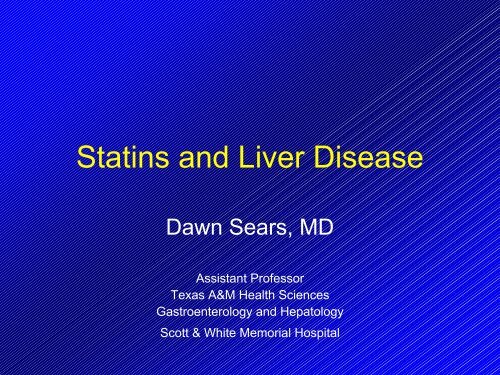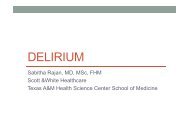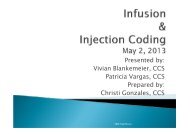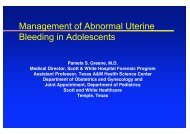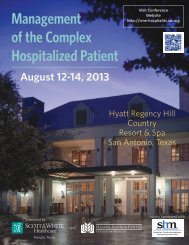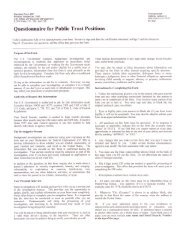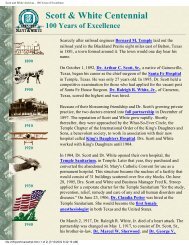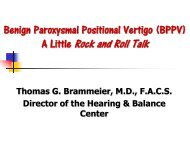Statins and Liver Disease - Healthcare Professionals
Statins and Liver Disease - Healthcare Professionals
Statins and Liver Disease - Healthcare Professionals
- No tags were found...
Create successful ePaper yourself
Turn your PDF publications into a flip-book with our unique Google optimized e-Paper software.
<strong>Statins</strong> <strong>and</strong> <strong>Liver</strong> <strong>Disease</strong>Dawn Sears, MDAssistant ProfessorTexas A&M Health SciencesGastroenterology <strong>and</strong> HepatologyScott & White Memorial Hospital
Clinical Question• A 55 yowm presents to your office for annual checkup. He is obese, otherwise healthy. Father died ofMI at age 61. Patient drinks “a 6 pack” on theweekends. His cholesterol is 280. LDL of 170. AST=80, ALT = 45, T Bili= 0.3. You are discussing statintherapy.– A. You plan on starting lipitor only if his LFT’s normalize offof EtOH.– B. You will offer him a statin now with recheck of LFT’s in 6weeks <strong>and</strong> recommend EtOH cessation.– C. You advise him to continue EtOH at “1 glass of wine anevening” <strong>and</strong> begin aggressive exercise program.– D. You refer him for a virtual colonoscopy because hischance of dieing from CRC far exceeds that as from CHD.
Overview• <strong>Statins</strong> <strong>and</strong> Cardiovascular <strong>Disease</strong>• Review of <strong>Statins</strong>• Review of Fibrates (Tricor)• Review of Niacin• Review of cholesterol binding resins• Review of other drug related liver diseases• NAFLD <strong>and</strong> cholesterol-lowering drugs
CHD <strong>and</strong> <strong>Statins</strong>• Coronary heart disease is number 1killer in the USA– 1 out of 5 deaths– Stroke is the number 3 killer• 1 out of 15 deaths• Statin use reduced coronary heartdisease by 20-40%– Primary prevention reduced first MI by 37%– Reduces stroke risk by 30%– Reduces all cause death by 25-30%
<strong>Statins</strong>• Lovastin - Mevacor• Simvastatin – Zocor• Pravastatin – Pravachol• Fluvastatin – Lescol• Atorvastatin – Lipitor• Cerivastatin – Baycol• Rosuvastatin – Crestor
Lovastatin/Mevacor
Lovastatin Mevacor• Isolated from Aspergillus terreus 1982• 1987- received FDA accelerated approval– Toxicology Studies abnormal– “<strong>Liver</strong> function tests be performed before initiationof treatment, at 6 <strong>and</strong> 12 weeks after initiation oftreatment or elevation in dose, <strong>and</strong> periodicallythereafter. Should an increase in AST or ALT of 3times the ULN or greater persist, withdrawal oftherapy with Mevacor is recommended”
Lovastatin• Toxicology studies– Rabbits (lower baseline HMG-CoA)• 100-200 mg/kg/day- hepatic necrosis–(800-2000 mg dose in humans)– Usual dose is 20-40 mg a day• Injury could be prevented with betternutrition/mevalonic acid–Dogs• Slight elevations in ALT without histologicdamage
Lovastatin• Premarketing clinical trials– 21% mild ALT increases– 1.9% >3 x ULN ALT:
Lovastatin• Pre-marketing Safety N = 2,045• Drug discontinued per protocol if >3 xULN in 15 (0.7%)– Rechallenge results•7- recurrence of elevation = drug related•3- probably drug-related• 3- alternative explanations• 2- negative rechallenge–Of the 10 drug related/probably drug related» 5 baseline ALT elevations» 7 regular ETOH use, 3 recent E-mycin
Lovastatin• Post-marketing- Phase IV• EXCEL- Exp<strong>and</strong>ed Clinical Evaluationof Lovastatin– N = 8,245– Double-blind placebo-controlled with modseverehypercholesterolemia• No prior LFT elevations• LFT’s checked Q 6 week• Any ALT elevation
• ALT > 3 x ULN• 4/45 were symptomatic– Nausea, anorexia, fatigue– All in 80 mg/day group– 7 had elevated alk phos– 1 had elevated T Bili– Risk factors presentLovastatin• Daily ETOH, obesity, baseline ALT elevation, increaseddose of Lovastatin
Lovastatin• AFCAPS/TexCAPS-Air Force/TexasCoronary Arteriosclerosis Prevention Study– N = 6,605– Lovastatin 20 mg vs. placebo x 5 years• Week 18- 1,657 increased to 40 mg• LFT’s at initiation, Q 6 wk x 1 year, Q 6 month• Exclusion LFT’s >1.2 ULN, 50% over IBW, IDDM–Results• Elevation LFT’s >3 x ULN– 18 (0.6%) Lovastatin vs. 11 (0.34%) Placebo– 14 normalized on treatment or had negative rechallenge» 3 other causes• 127 had levels 2-3 x ULN, 72% decreased to
Lovastatin• AFCAPS/TexCAPS, cont.– Patients with baseline elevated LFT’s• 136 Lovastatin vs. 130 Placebo• Of those ultimately 3 x ULN-– 1.1% had baseline elevation vs. 0.4% had baselinenormal LFT’s– Most with baseline elevations probably had NASH• Persistent elevation >3 X ULN– 2/136 Lovastatin vs. 1/130 Placebo
Lovastatin• WAES- Worldwide Adverse ExperienceDatabase– 17 cases “ALF”- Acute <strong>Liver</strong> Failure– 1 metastatic disease to liver– 2 Autoimmune hepatitis– 1 Decompensated PBC– 2 minor LFT elevation- death other cause– 1 Lupus– 1 friend of a friend with no documentation– 1 inquiry whether lovastatin could cause ALF– 2 “quit functioning” livers• 9 cases including AIH- possible related• 1 in 2.67 million patient-treatment years (equal toidiopathic Acute <strong>Liver</strong> Failure)
Lovastatin• Drug-interactions– Metabolized by cytochrome P 450 3A4– Concomitant inhibitor of CYP3A4• Erythromycin- associated with Multi organ failure• Other macrolide antibiotics- clarithromycin, azithromycin• Azole antibiotics- sulfamethoxazole, metronidazole• Cimetidine• Diltiazem• Estradiol/Estrogens• Quinidine• Grapefruit juice (200 mg for intestinal CYP3A4irreversible inhibition, 1 liter for hepatic CYP3A4inhibition)
Lovastatin• Case reports– Anicteric Hepatitis• 57 yo female 9 months• 59 yo female 3 years– Acute Cholestatic Hepatitis• 58 yo man 3 years• 54 yo woman 2 months– All with biopsy proven disease– All fully recovered with drug discontinuation
Simvastatin/Zocor
Simvastatin/Zocor• SSSS- Sc<strong>and</strong>inavian SimvastatinSurvival Study– Safety analysis 4444 x 5.4 years• Elevated LFT’s <strong>and</strong> hepatitis– 1.8% simvastatin vs. 1.4% placebo– All fully recovered– Italian study 100 simvastatin vs. 90pravastatin• 5% vs. 4.5% 3 x ULN within 6 months
Simvastatin/Zocor• Heart Protection Study (HPS)– N = 20,536– 40 mg vs. Placebo x 5 years• LFT’s 4 x ULN = 9 (0.09%) vs. 4 (0.04%)• All fully recovered
Simvastatin/Zocor• Case reports (metabolized by CYP3A4)– Simvastatin x 3 years, addition of diltiazem• Rhabdomyolysis <strong>and</strong> acute hepatitis– 68 yof with DM, hypercholesterolemia, self-resumedtroglitazone• Acute <strong>and</strong> severe hepatitis• Felt to be troglitazone mitochondrial toxicity• Myositis resolved, liver to cirrhosis in 12 weeks– Elderly woman with simvastatin <strong>and</strong> chlorzoxazone(CYP2E1) (Paraflex)• Cholestatic hepatitis• Resolved with drug withdrawal– 10 Case reports of acute hepatitis <strong>and</strong> elevated LFT’s• 4/10 Biopsy confirmed• All resolved with medication discontinuation
Atorvastatin/Lipitor
Atorvastatin/Lipitor• Pooled data published 1998 (Metabolized by CYP3A4)– 1845 patient-years of exposure• 1253 (50%) had 12 months plus• Withdrawal– Nausea, pain, depression, myalgia, pain, abnormal LFT’s– 0.3%- not dose- dependent– 30 patients with ALT x 3 ULN- only 11 (
Atorvastatin/Lipitor• 2001 MIRACL– N = 1072– 12 week check elevated LFT’s• 10 mg 0.2%• 80 mg 2.3%• Case Reports– Female with SLE receiving cyclophosphamide,choloroquine, prednisone, atrovastatin, calcium• After 6 th week- ALT 800, Tbili 8.2- normal INR• Viral causes eliminated• Atorvastatin discontinued- ALT <strong>and</strong> T Bili normalized in 5weeks
Pravastatin/Pravachol
Pravastatin/Pravachol• PPPP- Prospective Pravastatin PoolingProject– 112,000 person-years of exposure• ALT >3 x ULN– 1.4% pravastatin <strong>and</strong> 1.4% control– Gallbladder disease 1.9% vs. 2.1%– If pre-existing elevated LFT’s» 40.1% pravastatin vs. 38.5% placebo furtherelevations– No severe hepatotoxicity
Pravastatin/Pravachol• Case Reports (Not metabolized by P450 system)– 57 yo male started on pravastatin 20mg/day 7 weeks prior• Acute cholestatic hepatitis• Work up negative•Resolved7 weeks after discontinuation
Pravastatin• Pharmacokinetics– Not metabolized by P450 system– No significant change with other CYP3A4inhibitors• Verapamil, itaconazole, ketoconazole,clarithromycin , erythomycin, cyclosporine• Grapefruit juice
Fluvastatin/Lescol
Fluvastatin/Lescol• Synthetic HMG-CoA reductase inhibitor– Extensive first-pass metabolism• Metabolized by CYP2C9– No reports of hepatotoxicity• 2002 JAMA– Only patients with baseline elevations hadlater elevations• 0.2% on 20 mg• 2.7% on 80 mg
Cervistatin/Baycol
Cervistatin/Baycol• Approved 1997– 2001 study n = 1,263• LFT increase was dose-related• Recovered with drug discontinuation– 2001- Voluntarily withdrawn after 31deaths from rhabdomyosis• 12 on combination with Gemfibrozil•Noreports of hepatotoxicity
Rosuvastatin/Crestor
Rosuvastatin/Crestor• Newest statin– Minimal metabolism by CYP2C9• 90% excreted in feces– Phase III studies– N = 516- atorvastin vs. rosuvastatin• Reduction in LDL 35% vs. 43%• Side effects same- no hepatoxicity– STELLAR trial• Rosuvastatin vs. simvastatin vs. pravastatin• N = 1123• No patients required dose reduction or discontinuationfrom LFTs– Used in cirrhotics- n = 6• Well tolerated
Rosuvastatin/Crestor• ASTEROID study– JAMA 2006– 507 on high dose Crestor with IVUS exams–LFTs• > 3 x ULN- 9• > 3 x ULN more than once – 1 (0.2)–CKs• CK >5 x ULN- 6• CK >5 x ULN more than once – 1 (0.2)
Continuing…• <strong>Statins</strong> <strong>and</strong> Cardiovascular <strong>Disease</strong>• Review of <strong>Statins</strong>• Review of Fibrates (Tricor, Lopid)• Review of Niacin• Review of cholesterol binding resins• Review of other drug related liver diseases• NAFLD <strong>and</strong> cholesterol-lowering drugs
Fibrates• Fenofibrate (Tricor)• Gemfibrozil (Lopid)• GI side effects- 5%• H/A, loss of libido, dizziness, insomnia 3-4%• Rodent liver– Peroxisone proliferation– Hepatic carcinoma in high doses• Human liver– Increase AST <strong>and</strong> ALT- same as controls– Decrease alk phos, GGT, Bilirubin
Fibrates• Case reports– 5 patients with chronic hepatitis• 4 with hypergammaglobulinemia, increased ANA• <strong>Liver</strong> biopsy- lympho-plasmacytic infiltration• Cirrhosis in 3 on presentation <strong>and</strong> 2 later• Discontinuation of drug-– 3 normalized LFT’s– 2 required immunosuppresion for normalization– 1 patient with acute hepatitis <strong>and</strong> eosinophilia• Resolved with discontinuation• Recurred with rechallenge
Continuing…• <strong>Statins</strong> <strong>and</strong> Cardiovascular <strong>Disease</strong>• Review of <strong>Statins</strong>• Review of Fibrates (Tricor)• Review of Niacin• Review of cholesterol binding resins• Review of other drug related liver diseases• NAFLD <strong>and</strong> cholesterol-lowering drugs
Niacin• Multiple side effects• Flushing <strong>and</strong> palpitations• Worse DM, PUD, gout, hepatitis– SR- less flushing <strong>and</strong> palpitations• Hepatotoxic– Elevated LFT’s, steatosis, fulminant failure• 1992 Literature review of hepatotoxicity–6 IR–2 SR– 10 changed from IR to SR
Niacin• Combination– 1994 double blind r<strong>and</strong>omized (n = 74)• Fluvastatin vs. fluvastatin plus niacin• AST rise– 8.3% vs. 28.9%– None symptomatic or >3 x ULN– 2002 multicenter open-label (n = 814)• Niacin plus lovastain 40 mg– LFT’s >3 x ULN 0.5%– 10% withdrew for flushing–With ETOH• 44 yo male presented with encephalopathy
Niacin• Case reports– 46 yom 4 weeks Niacin 3 gram day• Elevated LFT’s• Rechallenge- fulminant hepatic failure• Resolved with discontinuation– 2 cases of “masses”- focal fatty areas– Resolved with discontinuation– 2 cases of hepatitis after large doses of nicotinicacid– 8 cases of hepatitis on SR niacin– 3 cases re-challenged with IR <strong>and</strong> no recurrence
Continuing…• <strong>Statins</strong> <strong>and</strong> Cardiovascular <strong>Disease</strong>• Review of <strong>Statins</strong>• Review of Fibrates (Tricor)• Review of Niacin• Review of cholesterol binding resins• Review of other drug related liver diseases• NAFLD <strong>and</strong> cholesterol-lowering drugs
Binding resins• Cholestyramine (Questran)• Colestipol (Colestid)• Colesevelam (Welchol)– Bind bile acids in intestine- prevents 90%reabsorption– GI side effects
Binding resins• Case reports– Colestipol• 65 yo male on drug x 3 months• LFT’s 10 x normal• Resolved within 4 weeks of discontinuation– Colesevelam- Welchol• 1400 patients alone <strong>and</strong> with statin• Side effects same as placebo
Ezetimibe/Zetia
New agent• Ezetimibe/Zetia– Selective cholesterol absorption inhibitor• Stops intestinal absorption, reduced cholesterol pool,increases hepatic LDL receptor activity• Not affect TG <strong>and</strong> fat-soluble vitamins– Clinical Efficacy• Monotherapy 15-20% decrease LDL• Combined with low-dose statin reduces LDL 20.7%– Vs. statin alone 6.7%• Combined with Simvastatin better than higher doseAtorvastatin at lowering LDL <strong>and</strong> increasing HDL
Ezetimibe/Zetia• Zetia with Atorvastatin vs.increased Atorvastatin (Amer Heart Jn=621) x 14 weeks– LFT elevations 1% vs. 0.3%– LDL decrease -23% vs. -8%
Ezetimibe & Simvastatin/Vytorin
Ezetimibe/Zetia/Vytorin• Zetia with Simvastatin x 48 weeks (Madridn=433) vs. simvastatin alone (after 14 weeks on astatin)– LFT elevations 0.3% vs. 0%– LDL decrease -24% vs. 3%• Zetia with Simvastatin in CRD patients x6 months (UK-HARP II n=203) vs. simvastatin alone– LFT elevations 0% vs. 4%– LDL decrease from baseline -40% vs. -26%
Ezetimibe/Zetia/Vytorin• VYVA study- Ezetimibe <strong>and</strong> simvastatinvs. Atorvastatin– 8 arm parallel-group 10 week study (n=1902)– Pooled data:•ALT >3 x ULN– 0.1 (Atorvastatin) vs. 1.2 (Vytorin)• Reached LDL goal– 81.1% (Atorvastatin) vs. 89.7% (Vytorin)Ballantyne, Abate. Dose-comparison study of the combinatin of ezetimibe <strong>and</strong> simvastatin vs atorvastainin patients with hypercholesterolemia: VYVA. AM Heart J (2005) 149;464-473.
Continuing….• <strong>Statins</strong> <strong>and</strong> Cardiovascular <strong>Disease</strong>• Review of <strong>Statins</strong>• Review of Fibrates (Tricor)• Review of Niacin• Review of cholesterol binding resins• Review of other drug related liver diseases• NAFLD <strong>and</strong> cholesterol-lowering drugs
Big Picture• Hepatotoxic reactions 1/130,000 generalpopulation– 1/114,000 for Statin drugs– 2-50/100,000 for NSAIDs• <strong>Liver</strong> transplant– 1/206,000,000 per treatment with statin• Only 1 patient between 1990-2002 received a livertransplant due to “statin-hepatotoxicity” (of 51,741)– 6/372,000,000 per treatment with NSAID• Most statins cause temporary increase LFT’s– Only long-acting Niacin unquestionably hepatotoxic
Acute <strong>Liver</strong> Failure in USA 1998-2001Unknown17%Shock6%Other14%Drug13%Hep B7%Hep A4%Tylenol39%TylenolHep AHep BDrugShockUnknownOther
Cause of 44 idiosyncratic drug reactionsresulting in acute liver failure 1998-2001
Drug Reactions• Isoniazid– 20% increased LFT’s– liver injury 1/100– fatality 1/10,000• Survival– Better- (>50%)• Acetaminophen, Acute Hepatitis A, ischemia, pregnancyrelated– Worse- (
NSAIDs• Bromfenac- 1999 NSAID withdrawn forcausing FHF•NSAIDsin patients with known liverdisease• Hepatorenal syndrome, diuretic resistantascites, GI bleeding- variceal bleeding• COX-2 inhibitors• Large trials no difference LFTs from placebo• 5 case reports of hepatocellular injury– All recovered with drug discontinuation
NSAIDs– Ibuprofen• Acute hepatitis, cholestasis, vanishing bile ductsyndrome, subfulminant hepatitis– Worsen LFT’s in chronic hepatitis C patients– Sulindac (Clinoril)• 91 cases to FDA– 43% cholestatic, 25% hepatocellular– 66% with hypersensitive features– 4 deaths- 1 FHF, 3 hypersensitivity– Diclofenac (Voltaren)• 200 cases to FDA– 1-5/100,000– Fever, rash 25%– FHF after rechallenge– CYP 2C9
Other anti-inflammatory• Leflunomide (Arava)• Rheumatoid arthritis• Trials 6.6% 2 x ULN, 4.4% 3 x ULN• European data 296 cases– 15 liver failure– 9 deaths liver-related– Most within 6 months initiation– 58% taking NSAIDs/MTX/ETOH, Hep C• Manufacturing recommendations– Monitor monthly x6, then QOM» Dose reduce» Use cholestyramine
Other anti-inflammatory• Infliximab (Remicade)– No hepatotoxicity pre-marketing– Case reports• 2 patients- elevated LFT’s (TB=19)• Resolution with discontinuation• Zafirlukast (Accolate)– Leukotreine receptor antagonist for asthma• LFT elevation 3.3% during trials• Case reports = 6– 2 liver failure to transplant– Eosinophilia, massive necrosis, respond to CCS
Continuing…• <strong>Statins</strong> <strong>and</strong> Cardiovascular <strong>Disease</strong>• Review of <strong>Statins</strong>• Review of Fibrates (Tricor)• Review of Niacin• Review of cholesterol binding resins• Review of other drug related liver diseases• NAFLD <strong>and</strong> cholesterol-lowering drugs
<strong>Statins</strong> in patients with baselineelevated LFT’s• Gastroenterology May 2004- Indiana-retrospective– 3 cohorts• Cohort 1- Elevated LFT’s (40/35) on statin (342)• Cohort 2- Normal LFT’s on statin (1437)• Cohort 3- Elevated LFT’s without a statin (2245)– All followed for first 6 months of therapy– Mild elevation of LFT’s (up to 10 x normal/baseline)– Severe elevation >10 x normal/baseline or TBili >3• Cohort 1- 4.7% mild, 0.6% severe• Cohort 2- 1.9% mild, 0.2% severe• Cohort 3- 6.4% mild, 0.4% severe (No statin therapy!)– Conclusion: Patients with baseline elevations of LFT’s do nothave worsened LFT’s on statin therapy compared to thosenot on statin therapy
<strong>Statins</strong> in patients with baselineelevated LFT’s• Am J Med Sci- Indiana- Lovastatin–3 Cohorts• Cohort 1- Elevated LFT’s on Lovastatin (135)• Cohort 2- Baseline normal LFT’s on Lovastatin (620)• Cohort 3- Elevated LFT’s without Lovastatin (2644)– 12 month follow up– Significant elevation of transaminases >5 xULN/baseline or TBili >3• Cohort 1- mild 6.6%, severe 0% (baseline ALT 46)• Cohort 2- mild 3.0%, severe 0.3% (baseline ALT 18)• Cohort 3- mild 11%, severe 5.5% (baseline ALT 56)– Conclusion: Patients with baseline elevations ofLFT’s IMPROVE LFT’s on statin therapycompared to those not on statin therapy
Statin Transaminitis in a largeHMO• American J of Medicine 2005, KaiserPermanente of Colorado– 1997-2001 all patients on statin– Transaminases >10 x ULN– Evaluate for cause, dechallenge <strong>and</strong>rechallenge– N = 30,000 on a statin
Transaminitis, cont.– 23,000 remained health plan member, not onchemotherapy <strong>and</strong> had LFT’s checked (76%)• 2% ALT 3-10x ULN• 0.3% n= 62 ALT >10 ULN– 74% n= 46 not statin related» 11 not on statin any more» 15 cholelithiasis» 8 viral hepatitis– 17 cases left» 4 on cyclosporine, 1 on erythromycin, 1 diltiazem, 1 onindinavir, 1 on fluoxetine, 1 on cimetidine, 1 on verapamil» Other 8: 2 in heart failure, ALL resolved within 8 weeks» 13 were rechallenged- 3 with recurrence- 2 of these hadsecond rechallenge with no recurrence on different statin
NASH <strong>and</strong> statins• Can J Gastroenterol 2003– Atorvastatin vs. urso in NASH patients– Followed x 6 months– More patients in Atorvastatin groupnormalized LFTs
CAD patients• Mortality study- The American J of Cardiology 1/2003– 15,000 1990-1996– Israel National Population Registry– 1,839 deaths• 57.4% cardiac• 34% noncardiac– 16% cancer–5% CVA–4% Sepsis–0.6% PE– 6.5% other (liver 0.03% 7)• 8.6% unknown
CAD• “Poly-portfolio” for secondary prevention– Am J Cardiology 2005– High dose statin, antihypertensive therapy, ASA,omega-3 fish oil, cardiac rehab, <strong>and</strong> diet• CHD decrease 84%• MI decrease 91%• Stroke decrease 77%• Pharmacologic therapy results in 93% decrease insecond cardiac event, while lifestyle changes add 4%over 5 years
CAD• UK population-based study– 1.18 million patients– 13,029 with MI 1996-2003– Statin use resulted in 39% lower all causemortality– Longer duration = more benefit (19% peryear after 2 years)– Same for atorvastatin vs. simvastatinHippisley-Cox. Effect of statins on the mortality of patients with ischaemic heart diesease:population based cohort study with nested case-controlanalysis. Heart 2006;92(6):752-8.
Current Statin use• >10 million patients on statin therapy inthe US alone– LFT’s $60 each– Abnormal results often result in 10 x thecost to evaluate– Never proven cost-effective to “screen” forAcute <strong>Liver</strong> Failure– Acute <strong>Liver</strong> Failure occurs over days, notmonths
Future Statin Use• Search for noncholesterolbenefits over last2 months inmedicalliterature:• Decreased sepsis mortality• Decreased fractures• Decreased Breast cancer• Decreased Colon Cancer• Decreased HTN• Improved Arthritis• Improved Ankylosing spondylitis• Treatment for acute subarachnoidhemorrhage• Treatment for polycystic ovarian syndrome• Treatment for migraines• Use in orthodontics• Treatment for lymphoma induced ascites• Lower risk of GI bleed
Future Statin Use• Pravastatin/Pravachol• Simvastain/Zocor• Both to go generic this summer!
Evidence Based Conclusions• Statin therapy does cause elevation of LFT’sat high doses• Statin therapy does not, in <strong>and</strong> of itself,result in liver failure, cirrhosis or chronicliver disease• Monitoring of LFTs does not prevent liverdamage, but may reveal underlying cause ofliver disease• Patients with baseline LFT elevation can besafely placed on statins
Clinical Conclusion• Use <strong>Statins</strong> in patients who need them– Advise ETOH cessation– Stop statin temporarily if using CYP3A4 inhibitor• Clarithromycin, erythromycin, itraconazole, ect.– Switch statin if long-term CYP3A4 inhibitor drugnecessary• Amiodarone, diltiazem, verapamil, fluoxetine, ect.• Switch to Pravachol, Lescol, Crestor• Follow LFT’s only at 6 weeks after initiation<strong>and</strong> dose changes or if symptomatic• If elevated >3 x ULN (AST- 120, ALT- 90)– Work-up for chronic liver disease– Consider dose reduction of statins– Consider switching to Crestor
Workup of Chronic <strong>Liver</strong> <strong>Disease</strong>• Check for Chronic hepatitis– Hep C antibody, Hep B surface Antigen• Check for iron overload or Hemochromatosis– Ferritin, TIBC• Check for underlying Autoimmune liverdisease– ANA, anti-liver kidney antibody, AMA, SPEP• Consider A1-antitrypsin deficiency, Wilson’sdisease, other drug (methotrexate,amiodarone, diltiazem)• Consider referral to Hepatology to confirmNASH with biopsy
LovastatinSimvastatinPravastatinFluvastatinAtorvastatinRosuvastatinEzetimibeFenofibrateGemfibrozilColestipolNiacinP450 metabolismCYP3A4CYP3A4Minimal/NoneCYP2C9CYP3A4Minimal CYP2C9NoneNoneRenal clearNon-absorbedNoneHepatotoxicWith inhibitorWith inhibitorWith inhibitorYes
CYP3A4 inhibitors• Amiodarone• Cimetidine• Ciprofloxacin• Clarithromycin• Cyclosporine• Danazol• Delavirdine• Diltiazem• Efavirenz• Erythromycin• Fluconazole• Fluoxetine• Fluovaxamine• Grapefruit juice• Indinavir• Isoniazid• Itraconazole• Ketaconazole• Metronidazole• Micronazole• Nefazodone• Nelfinavir• Nifedipine• Norfloxacin• Quinine• Ritonavir• Roxithromycin• Saquinavir• Sertralin• Trole<strong>and</strong>omycin• Verapamil• Voriconazole• Zafirlukast• Zileuton
References• Parra J, Reddy K. Hepatotoxicity of hypolipidemic drugs. Clinics in<strong>Liver</strong> <strong>Disease</strong>, 2003;7.• Schiodt F, Lee W. Fulminant liver disease. Clinics in <strong>Liver</strong> <strong>Disease</strong>,2003;7.• Dujovne C. Side effects of statins: hepatitis vs. “transaminitis”. TheAmerican J of Cardiology, 2002;89.• Dankner R, Golbourt U, Boyko V, et al. Predictors of cardiac <strong>and</strong>noncardiac mortality among 14,697 patients with coronary heartdisease. The American J of Cardiology, 2003;91.• Russo M, Jacobson I. How to use statins in patients with chronic liverdisease. Clevel<strong>and</strong> Clinic, 2004;71:58-62.• Chituri S, George J. Hepatotoxicity of commonly used drugs:NSAIDs,antihypertensives, antidiabetic agents, anticonvulsants, lipid-loweringagents, psychotropic drugs. Sem <strong>Liver</strong> Dis, 2002;22:169-183.• Chalasani N, Aljadhey H, Kesterson J, et al. Patients with elevatedliver enzymes are not at higher risk for statin hepatotoxicity.Gastroenterology 2004;126:1287-92.• Vuppalanchi R. Patients with elevated baseline liver enzymes do nothave higher frequency of hepatotoxicity from lovastatin than those withnormal baseline liver enzymes. Am J Med Sci 2005;329:62-5.


